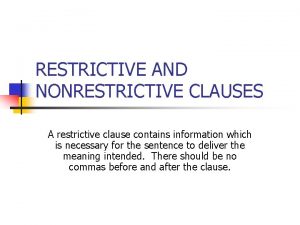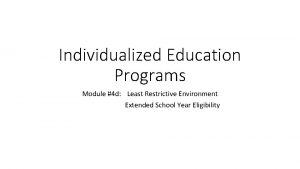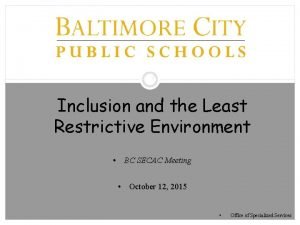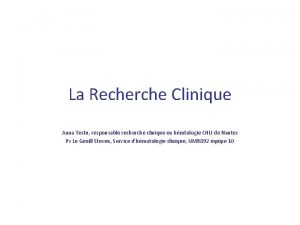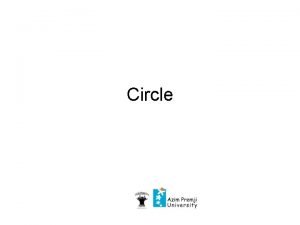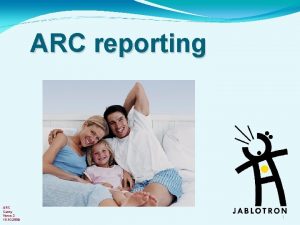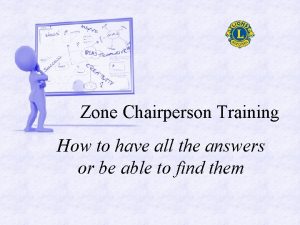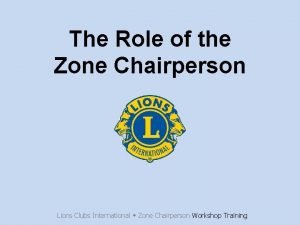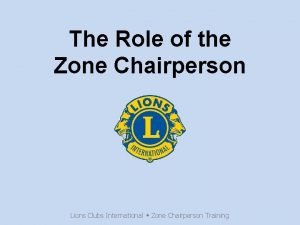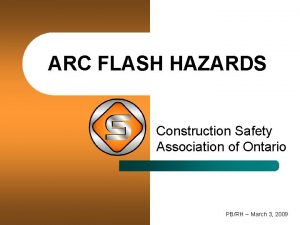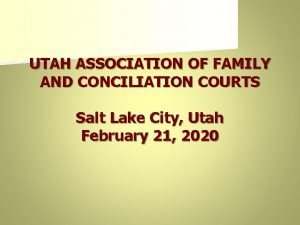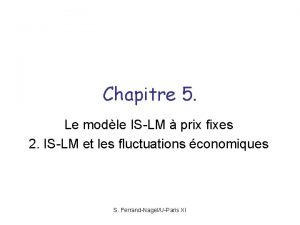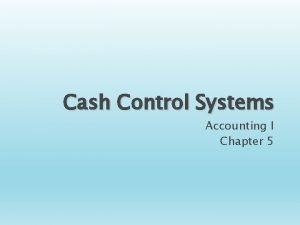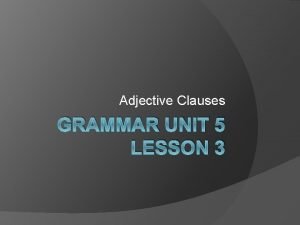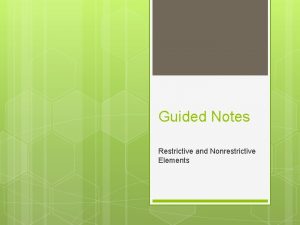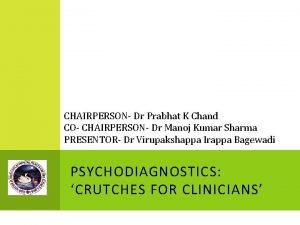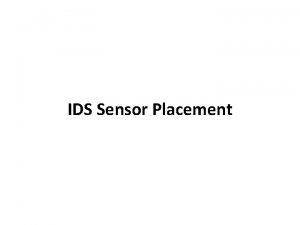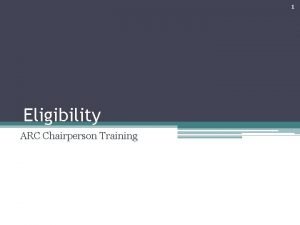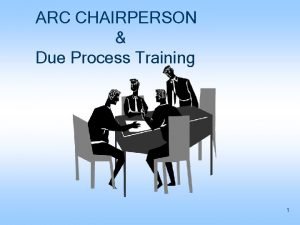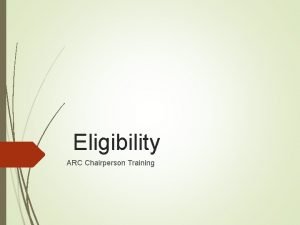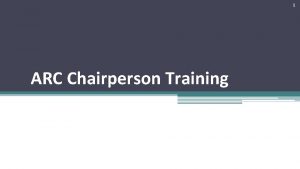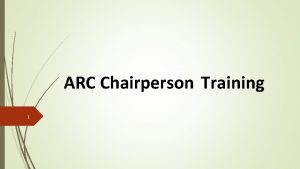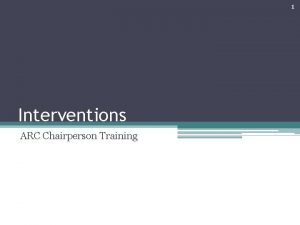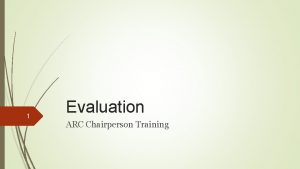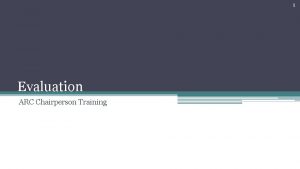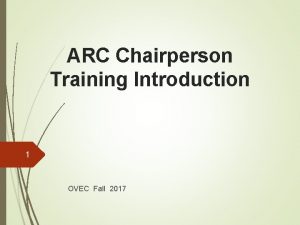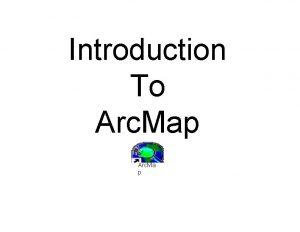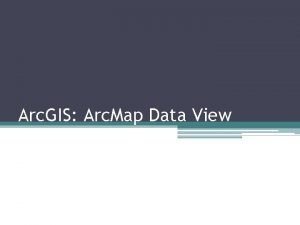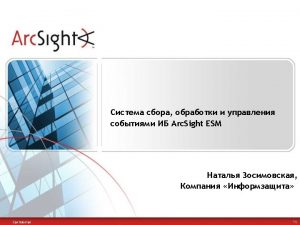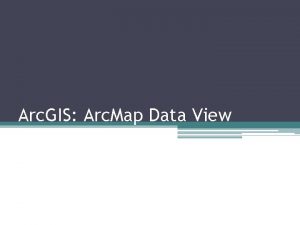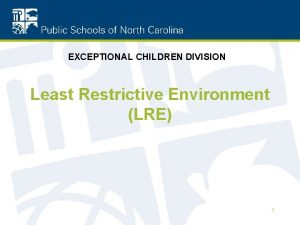1 Placement ARC Chairperson Training 2 Least Restrictive
























- Slides: 24

1 Placement ARC Chairperson Training

2 Least Restrictive Environment (LRE) To the maximum extent appropriate, children with disabilities, including children in public and private institutions or other care facilities, are educated with children who are not disabled, and special classes, separate schooling, or other removal of children with disabilities from the regular educational environment occurs only when the nature or severity of the disability of a child is such that education in regular classes with the use of supplementary aids and services cannot be achieved satisfactorily. IDEA Section 1412(5)(A)

3 Continuum of Services General Classroom with Co-teaching Resource Setting Special Class (Self-contained Classroom) Specialized School Setting Home/Hospital

4 Four Rules to LRE • Consider the regular education classroom for every student • Consider as possible modifications, aids, and services in regular education classroom • Consider special education class or resource room for part of day before considering special class full day • Consider a more restrictive placement if appropriate, those options being special schools, home instruction, hospitals or institutions

5 Location and Placement The ARC reviews the Present Levels, Student Performance Data and services identified on the IEP to determine the location of service provision. IEP Guidance Document, page 50

6 Continuum of Services All children have a right to continuum of services and placements to meet their individual needs. Regular Education Special Classes Special Schools Majority of students are served in the regular classroom for all or part of the school day. Home Instruction Institutions

7 Placement is Not Based on: Disability Curriculum Content School Organization Service Availability Instructional Methods Space Availability

8 Placement: What or Where? • Placement is where the student will receive special education and related services. • Decisions must be made in conformity with the standard of least restrictive environment. • IDEA’s strong preference is that to maximum extent appropriate, students educated in regular setting with nondisabled peers.

9 Consideration of Potential Harmful Effects q ARC identifies any potential harmful effects of the placement on the child or youth or on the quality of services required. q ARC specifies in writing modifications to be made to compensate for any identified harmful effects.

10 Consideration of Potential Harmful Effects Example: Jessica’s emotional/behavioral disability requires placement in a special class because her extreme level of anxiety is often triggered by large groups, non-structured settings. She will have opportunities to participate in field trips and school based community activities to compensate for separate instruction from nondisabled peers.

11 Consideration of Potential Harmful Effects Example: Jackson is returning mid-year from a 12 -week day treatment program to a large comprehensive high school where he will participate in two resource classes (English II and Geometry) and regular classes for Electives, History and Chemistry. Change and forming relationships are difficult for Jackson. To support transition to a new school and new trimester, the Special Education Teacher and Jackson will meet with each teacher (general education and special education) and review his IEP and BIP. During the trimester, if needed, Jackson will use a green pass to go to the special education teacher’s classroom or counselor’s office for consultation.

12 Change of Placement School Personnel may remove a student with a disability who violates the code of conduct from the student’s placement to an appropriate interim alternative education setting, another setting, or suspension, for not more than 10 consecutive school days - 707 KAR 1: 340 Section 13 (2)

13 11 th Day Services • Considered a change of placement • Determined on a case-by-case basis • Must conduct a manifestation determination • Must still continue to receive FAPE

14 Manifestation Determination Within 10 days of any decision to change the placement of a child with a disability because of a violation of a code of student conduct �Conduct caused by or have a direct and substantial relationship to the disability �Conduct was the direct result of the LEA failing to implement the IEP

15 Manifestation Determination Relevant members of the ARC consider all information �Conduct caused by the disability OR �LEA did not implement the IEP 707 KAR 1: 340 Section 14

16 If the ARC determines behavior was a manifestation of disability • Conduct a functional behavioral assessment (FBA), unless previously conducted and BIP developed • Review the BIP (if one has already been developed), and modify as necessary • Return student to the placement from which the student was removed unless parent and district agree to change of placement

17 Interim Alternative Education Setting • Instances in which school personnel order the removal of children with disabilities from their current educational placement to an appropriate interim alternative educational setting for no more than 45 school days

18 Interim Alternative Education Setting • The ARC is responsible for determining the interim alternative educational setting • Applicable for students with disabilities who: ▫ Possess a weapon on school premises ▫ Use or sell illegal drugs ▫ Inflicts serious bodily injury upon another person 707 KAR 1: 340 Section 14 (5)

19 Interim Alternative Education Setting • Student may continue to progress in the general curriculum • IEP services continue in order to meet goals • Placement includes services to address behavior and prevent behavior from recurring

20 Related Services Transportation and developmental, supportive, or corrective services which are needed by a student with a disability to benefit from special education. ▫ Related services complement and supplement the Specially Designed Instruction provided to the student 707 KAR 1: 002 Section 51

21 Special Transportation • Under IDEA, the LEA provides nonacademic and extracurricular services and activities so that children with disabilities have an equal opportunity for participation in those services and activities. • In arranging for the nonacademic and extracurricular services and activities, including transportation, the LEA must make sure that the child with disabilities participates with children who do not have disabilities to the maximum extent appropriate to the needs of the child with disabilities.

22 Transfer Students If a child with a disability transfers between school districts within the same academic year within Kentucky and had an IEP in effect, • The child shall be provided a free and appropriate public education(FAPE), including services comparable to those described in the previous IEP. • These services shall be provided in consultation with the parents and until the LEA adopts the previous IEP or develops and implements a new IEP.

23 Out of State Transfer Students If a child with a disability transfers between school districts within the same academic year from outside the state and had an IEP in effect in another state, • The child shall be provided FAPE comparable to that described in the IEP until the LEA conducts an evaluation if determined necessary, • and develops, adopts, and implements a new IEP, If the child meets the eligibility criteria as defined in 707 KAR 1: 280

24 Out of State Transfer Students • If a student enrolls in a KY district with a current IEP, the district must implement that IEP to the maximum extent possible • KY eligibility must be determined. The ARC must review all documentation to determine what evaluation information must be gathered
 Examples of restrictive clauses
Examples of restrictive clauses Least restrictive environment statement examples
Least restrictive environment statement examples Least restrictive environment examples
Least restrictive environment examples Define least restrictive environment
Define least restrictive environment Arc promoteur vs arc investigateur
Arc promoteur vs arc investigateur Parts of a circle
Parts of a circle What is a minor arc
What is a minor arc Arc emu88 com arc info 57 100057 html
Arc emu88 com arc info 57 100057 html Lions club marketing communications chairperson
Lions club marketing communications chairperson Bryneven primary school
Bryneven primary school Bryneven primary school
Bryneven primary school Zone chairperson manual
Zone chairperson manual Zone chairperson
Zone chairperson Lions club zone chairperson
Lions club zone chairperson Systemic reforms of ncf 2005
Systemic reforms of ncf 2005 Arc flash training ontario
Arc flash training ontario Unjustified restrictive gatekeeping
Unjustified restrictive gatekeeping Obstructive vs restrictive lung disease
Obstructive vs restrictive lung disease Politique monetaire restrictive
Politique monetaire restrictive Asbestos bodies
Asbestos bodies Dapsicamp
Dapsicamp Politique monetaire restrictive
Politique monetaire restrictive Endorse a check to someone else
Endorse a check to someone else Adjectival relative clause
Adjectival relative clause Restrictive clause
Restrictive clause
